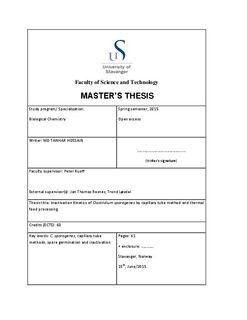| dc.contributor.author | Hossain, Md Tanhar | |
| dc.date.accessioned | 2015-09-16T13:56:13Z | |
| dc.date.available | 2015-09-16T13:56:13Z | |
| dc.date.issued | 2015-06-15 | |
| dc.identifier.uri | http://hdl.handle.net/11250/300340 | |
| dc.description | Master's thesis in Biological chemistry | nb_NO |
| dc.description.abstract | This master thesis is a part of the projects Salt Process and KonSpor (control of spore-forming bacteria in food with medium and long durability) and financed by the foundation “NORCONSERV”. This study is an integrated part of these projects where different techniques have been applied and documented to know how spores of pathogenic bacteria can be killed and how to develop new safe foods when reduced amount of salt is used during processing. This study has a special focus on thermal inactivation of spores by capillary tube methods and the effect of salt concentration on spore inactivation during heat treatment. Autoclave was also done by single and double heat treatment (Tyndallization) for further documentation of food product processing. As a target for the heat treatment, proteolytic Clostridium botulinum was selected for this study. The laboratory is not certified for working with C. botulinum. Clostridium sporogenes was selected as a surrogate of C. botulinum. C. sporogenes is a non-pathogenic spore forming bacteria often regarded as more heat resistant than C. botulinum.
The objective of this study is to determine the effect of salt concentrations used in foods on inactivation kinetics of C. sporogenes strain CCUG 7489 and compare the heat resistance among different strains of C. sporogenes (PA 3679, CCUG 24143 and CCUG 7489) by using classical heat treatment in capillary tubes. The second objective is to study the C. sporogenes spore inactivation using heat by autoclave on meat product.
In the first experimental design, three strains of C. sporogenes (PA 3679, CCUG 7489 and CCUG 24143) were used for heat treatment in capillary tube to determine the heat resistance of the spores. Capillary tube experiment was also used to document the effect in the survival of spores (CCUG 7489) with various salt concentrations. The second experimental design was done by autoclave to study the effect of single and double heat treatment and the inactivation process of spores in a minced meat ‘model-product’.
With the capillary tube method, D-values were calculated to determine the inactivation kinetics of C. sporogenes. This method follows the linear first order kinetics and all three strains were studied to identify the most heat stable strains at 90 °C. PA 3679 was found less heat resistant among them. The D-values were calculated at 85 °C for strain CCUG 24143 (since no survival was found at 90 °C) and at 85 °C and 90 °C for CCUG 7489 to select for the salt experiment.
3
Different salt concentrations (0%, 3% and 6% NaCl w/v) were used to study the difference in killing of the spores during heat treatment.
The thermal inactivation for C. sporogenes by autoclave was done to study the difference between single and double heat treatment. It was also an objective to study the inoculated food product (minced meat) by thermal inactivation process. The inactivation in meat products was slower compared to the obtained D-values from the capillary tubes. Single heat treatment at 90 °C for 30 min reported in 1 log reduction of spores. After double heat treatment at 80 °C for 60 min and 90 °C for 30 min with holding time at 25 °C for 75 min in between, 1.3 log reductions were found. However, no difference was observed for spore reduction between single and double heat treatment. | nb_NO |
| dc.language.iso | eng | nb_NO |
| dc.publisher | University of Stavanger, Norway | nb_NO |
| dc.relation.ispartofseries | Masteroppgave/UIS-TN-IMN/2015; | |
| dc.subject | C. sporogenes | nb_NO |
| dc.subject | capillary tube methods | nb_NO |
| dc.subject | spore germination | nb_NO |
| dc.subject | inactivation | nb_NO |
| dc.subject | biologisk kjemi | nb_NO |
| dc.title | Inactivation kinetics of Clostridium sporogenes by capillary tube method and thermal food processing | nb_NO |
| dc.type | Master thesis | nb_NO |
| dc.subject.nsi | VDP::Mathematics and natural science: 400::Basic biosciences: 470::Biochemistry: 476 | nb_NO |
